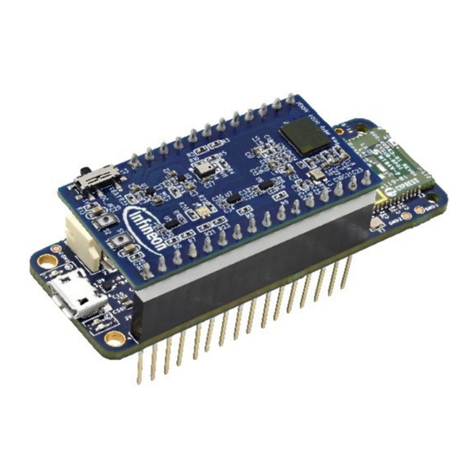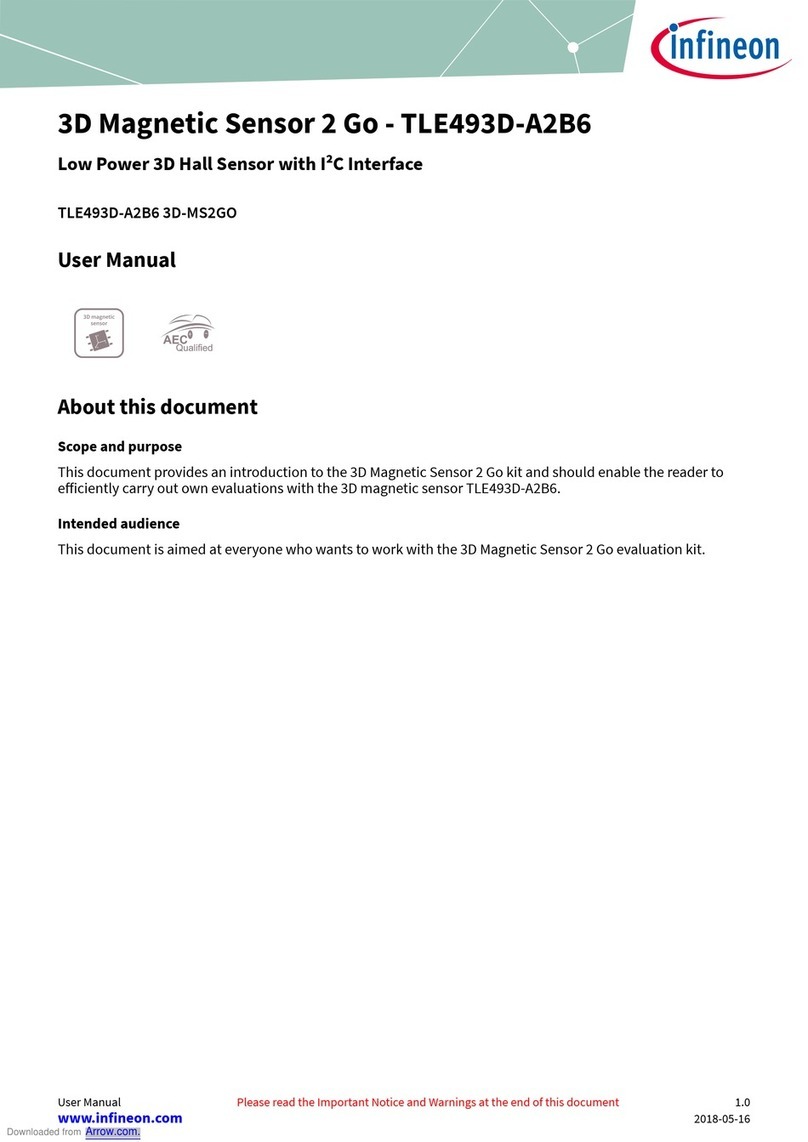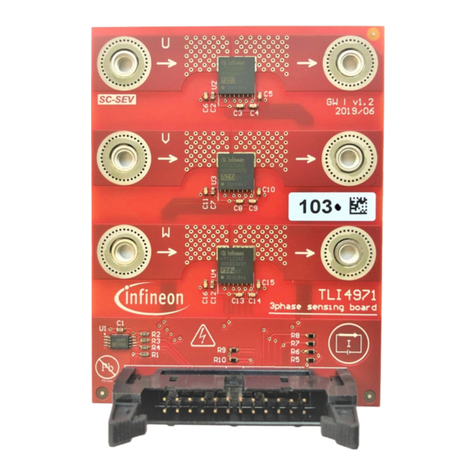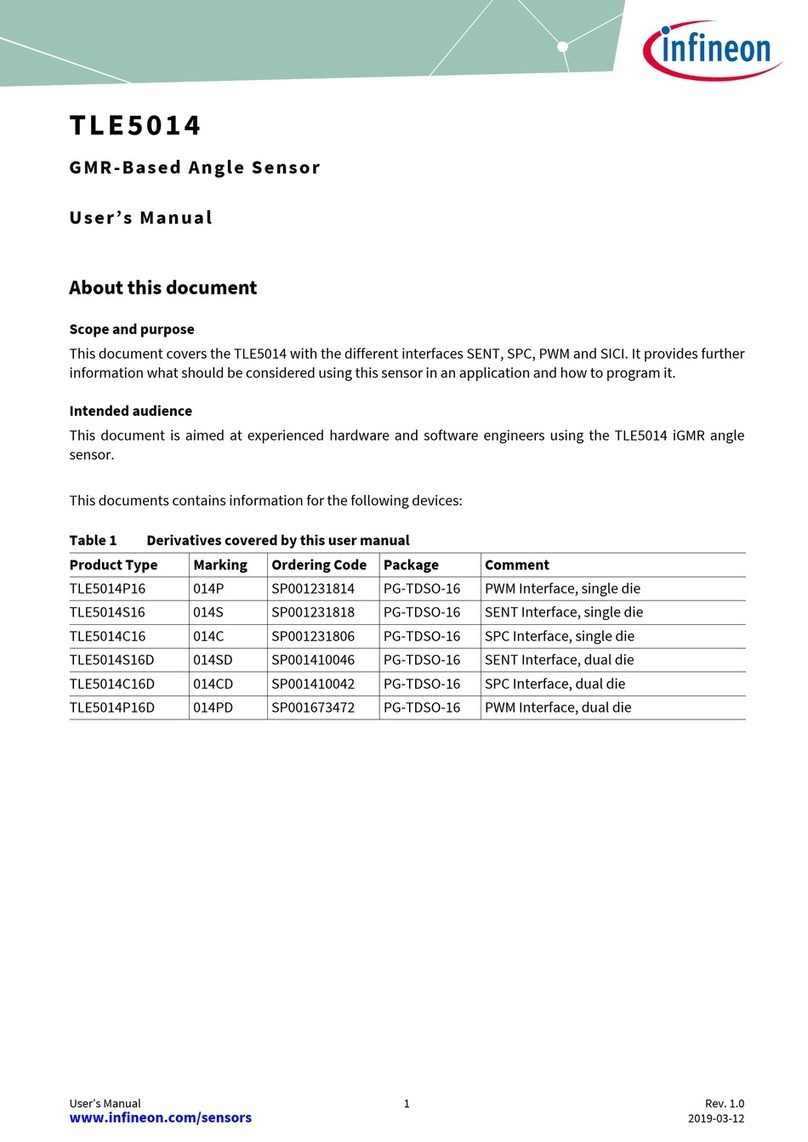Infineon TLE4997 User manual

Sense & Control
User’s Manual
v01_01, 2019-08
TLE4997
Configuration and Calibration of Linear Hall Sensor

Edition 2019-08
Published by
Infineon Technologies AG
81726 Munich, Germany
© 2019 Infineon Technologies AG
All Rights Reserved.
Legal Disclaimer
The information given in this document shall in no event be regarded as a guarantee of conditions or
characteristics. With respect to any examples or hints given herein, any typical values stated herein and/or any
information regarding the application of the device, Infineon Technologies hereby disclaims any and all warranties
and liabilities of any kind, including without limitation, warranties of non-infringement of intellectual property rights
of any third party.
Information
For further information on technology, delivery terms and conditions and prices, please contact the nearest
Infineon Technologies Office (www.infineon.com).
Warnings
Due to technical requirements, components may contain dangerous substances. For information on the types in
question, please contact the nearest Infineon Technologies Office.
Infineon Technologies components may be used in life-support devices or systems only with the express written
approval of Infineon Technologies, if a failure of such components can reasonably be expected to cause the failure
of that life-support device or system or to affect the safety or effectiveness of that device or system. Life support
devices or systems are intended to be implanted in the human body or to support and/or maintain and sustain
and/or protect human life. If they fail, it is reasonable to assume that the health of the user or other persons may
be endangered.

TLE4997
User’s Manual
Table of Contents
User’s Manual 3 v01_01, 2019-08
Table of Contents . . . . . . . . . . . . . . . . . . . . . . . . . . . . . . . . . . . . . . . . . . . . . . . . . . . . . . . . . . . . . . . . 3
1Scope . . . . . . . . . . . . . . . . . . . . . . . . . . . . . . . . . . . . . . . . . . . . . . . . . . . . . . . . . . . . . . . . . . . . . . . . . . 4
2 TLE4997 Signal Processing . . . . . . . . . . . . . . . . . . . . . . . . . . . . . . . . . . . . . . . . . . . . . . . . . . . . . . . . 4
3 TLE4997 Programming . . . . . . . . . . . . . . . . . . . . . . . . . . . . . . . . . . . . . . . . . . . . . . . . . . . . . . . . . . . . 5
3.1 Programmer Connection . . . . . . . . . . . . . . . . . . . . . . . . . . . . . . . . . . . . . . . . . . . . . . . . . . . . . . . . . . . . 5
3.2 Programming Interface . . . . . . . . . . . . . . . . . . . . . . . . . . . . . . . . . . . . . . . . . . . . . . . . . . . . . . . . . . . . . 6
3.2.1 Communication Scheme . . . . . . . . . . . . . . . . . . . . . . . . . . . . . . . . . . . . . . . . . . . . . . . . . . . . . . . . . . 6
3.3 Command Frame . . . . . . . . . . . . . . . . . . . . . . . . . . . . . . . . . . . . . . . . . . . . . . . . . . . . . . . . . . . . . . . . . 7
3.3.1 Data Frame . . . . . . . . . . . . . . . . . . . . . . . . . . . . . . . . . . . . . . . . . . . . . . . . . . . . . . . . . . . . . . . . . . . . 8
3.3.2 Interface Specification . . . . . . . . . . . . . . . . . . . . . . . . . . . . . . . . . . . . . . . . . . . . . . . . . . . . . . . . . . . . 8
3.4 Register Map . . . . . . . . . . . . . . . . . . . . . . . . . . . . . . . . . . . . . . . . . . . . . . . . . . . . . . . . . . . . . . . . . . . 11
3.5 EEPROM Map . . . . . . . . . . . . . . . . . . . . . . . . . . . . . . . . . . . . . . . . . . . . . . . . . . . . . . . . . . . . . . . . . . 13
3.6 Programming Flow . . . . . . . . . . . . . . . . . . . . . . . . . . . . . . . . . . . . . . . . . . . . . . . . . . . . . . . . . . . . . . . 14
3.6.1 Setting the TEST register . . . . . . . . . . . . . . . . . . . . . . . . . . . . . . . . . . . . . . . . . . . . . . . . . . . . . . . . 16
3.6.2 Readout of the EEPROM Content . . . . . . . . . . . . . . . . . . . . . . . . . . . . . . . . . . . . . . . . . . . . . . . . . . 16
3.6.3 Setting the EEPROM Content . . . . . . . . . . . . . . . . . . . . . . . . . . . . . . . . . . . . . . . . . . . . . . . . . . . . . 16
3.6.4 Calculation of Bits to Erase . . . . . . . . . . . . . . . . . . . . . . . . . . . . . . . . . . . . . . . . . . . . . . . . . . . . . . . 16
3.6.5 Calculation of Bits to Write . . . . . . . . . . . . . . . . . . . . . . . . . . . . . . . . . . . . . . . . . . . . . . . . . . . . . . . . 16
3.6.6 Margin Voltage Check . . . . . . . . . . . . . . . . . . . . . . . . . . . . . . . . . . . . . . . . . . . . . . . . . . . . . . . . . . . 17
3.6.7 DATA access example . . . . . . . . . . . . . . . . . . . . . . . . . . . . . . . . . . . . . . . . . . . . . . . . . . . . . . . . . . 17
3.6.8 Temporary overwrite of EEPROM data . . . . . . . . . . . . . . . . . . . . . . . . . . . . . . . . . . . . . . . . . . . . . . 18
3.6.9 DAC setup example . . . . . . . . . . . . . . . . . . . . . . . . . . . . . . . . . . . . . . . . . . . . . . . . . . . . . . . . . . . . . 19
4 Configuration & Calibration Parameters . . . . . . . . . . . . . . . . . . . . . . . . . . . . . . . . . . . . . . . . . . . . 20
4.1 Magnetic Field Range - R . . . . . . . . . . . . . . . . . . . . . . . . . . . . . . . . . . . . . . . . . . . . . . . . . . . . . . . . . . 20
4.2 Gain Setting - G . . . . . . . . . . . . . . . . . . . . . . . . . . . . . . . . . . . . . . . . . . . . . . . . . . . . . . . . . . . . . . . . . 20
4.3 Offset Setting - OS . . . . . . . . . . . . . . . . . . . . . . . . . . . . . . . . . . . . . . . . . . . . . . . . . . . . . . . . . . . . . . . 20
4.4 Low-Pass Filter - LP . . . . . . . . . . . . . . . . . . . . . . . . . . . . . . . . . . . . . . . . . . . . . . . . . . . . . . . . . . . . . . 21
4.5 DAC Input Interpolation Filter . . . . . . . . . . . . . . . . . . . . . . . . . . . . . . . . . . . . . . . . . . . . . . . . . . . . . . . 22
4.6 Clamping - CH, CL . . . . . . . . . . . . . . . . . . . . . . . . . . . . . . . . . . . . . . . . . . . . . . . . . . . . . . . . . . . . . . . 23
4.7 Temperature Compensation - TL, TQ & TT . . . . . . . . . . . . . . . . . . . . . . . . . . . . . . . . . . . . . . . . . . . . 24
5 Calibration of TLE4997 Temperature Compensation . . . . . . . . . . . . . . . . . . . . . . . . . . . . . . . . . . 25
5.1 Integrated Temperature Polynomial . . . . . . . . . . . . . . . . . . . . . . . . . . . . . . . . . . . . . . . . . . . . . . . . . . 25
5.2 Application Sensitivity Polynomial . . . . . . . . . . . . . . . . . . . . . . . . . . . . . . . . . . . . . . . . . . . . . . . . . . . 25
5.3 Determination of Sensitivity Polynomial from Measurement . . . . . . . . . . . . . . . . . . . . . . . . . . . . . . . 27
5.4 Calculation of Final Temperature Compensation Parameters . . . . . . . . . . . . . . . . . . . . . . . . . . . . . . 28
5.4.1 Algorithm for Finding the Optimum Temperature Coefficient Set . . . . . . . . . . . . . . . . . . . . . . . . . . 28
5.4.2 Example Implementation Code for Temperature Calibration . . . . . . . . . . . . . . . . . . . . . . . . . . . . . . 29
5.5 Usage of Infineon’s Temperature Calibration Tool . . . . . . . . . . . . . . . . . . . . . . . . . . . . . . . . . . . . . . . 32
6 Calibration of TLE4997 Output Characteristic . . . . . . . . . . . . . . . . . . . . . . . . . . . . . . . . . . . . . . . . 34
6.1 Two-Point Calibration Procedure . . . . . . . . . . . . . . . . . . . . . . . . . . . . . . . . . . . . . . . . . . . . . . . . . . . . 34
6.2 Two-Point Calibration Examples . . . . . . . . . . . . . . . . . . . . . . . . . . . . . . . . . . . . . . . . . . . . . . . . . . . . . 35
6.2.1 Calibration with Application Readout . . . . . . . . . . . . . . . . . . . . . . . . . . . . . . . . . . . . . . . . . . . . . . . . 35
6.2.2 Calibration without Application Readout . . . . . . . . . . . . . . . . . . . . . . . . . . . . . . . . . . . . . . . . . . . . . 36
Table of Contents

TLE4997
User’s Manual
Scope
User’s Manual 4 v01_01, 2019-08
1Scope
This document is valid for all TLE4997 variants and derivates. It gives a detailed description of the configuration
and calibration procedure, which is recommended to configure the TLE4997 for optimum accuracy in a sensing
application.
2 TLE4997 Signal Processing
The TLE4997 uses a fully digital signal processing concept. Analog values from the Hall probe are directly
converted to raw digital signals by the Hall ADC and then compensated and processed in the digital signal
processing unit (DSP) using configuration parameters stored in the EEPROM and the temperature data acquired
by an integrated temperature sensor. A configurable second-order temperature polynomial is implemented to
compensate the thermal reduction of the remanent magnetic flux of a permanent magnet used in a position
sensing application. Additionally, an application-specific output characteristic can be set by configuring the
EEPROM parameters of Gain and Offset.
Figure 2-1 Signal Flow Diagram of the TLE4997
Figure 2-1 shows the signal flow diagram for temperature compensation and output characteristic in the DSP, and
the influence of the relevant configuration parameters stored in the EEPROM. The Hall signal is processed in the
following sequence of steps:
1. The analog Hall signal is converted by the Hall ADC, which operates at the configured magnetic range setting.
2. The digital value is filtered by a digital low-pass filter, which operates at a configurable filter frequency given
by the “LP filter”-setting. The output of the filter is stored in the HADC register.
3. The HADC value is multiplied by the temperature compensation polynomial and stored in the HCAL register.
The first order (TL) and second order (TQ) coefficients of the polynomial are configurable. The third order
coefficient (TT) is fixed.
4. The HCAL value is multiplied by the configured gain value.
5. The configured offset value is added to the HCAL value.
6. The digital Hall value is clamped according to the configured upper and lower clamping limits. The output value
of the clamping stage is converted from digital to analog.
7. An output voltage is transmitted on the OUT pin and is proportional to the supply voltage (ratiometric DAC).
Stored in
EEPROM
Memory
+
A
D
Hall
Sensor
Limiter
(Clamp)
Out
X
Range LP
Offset
Gain
x
Clamping Low
Clamping High
A
D
TADC TCAL
Temperature
Sensor
Norm-
alize T-Polynomial
TL
TT
TQ
HADC
HCAL
VOUT
D
A
VDAC

TLE4997
User’s Manual
TLE4997 Programming
User’s Manual 5 v01_01, 2019-08
3 TLE4997 Programming
3.1 Programmer Connection
Figure 3-1 shows the connection of the TLE4997 to a programmer. The pins VDD and OUT of the sensor IC are
used for the digital programming interface as described in Table 3-1 (See datasheet of corresponding TLE4997
type for pinout).
Figure 3-1 Connection of TLE4997 to Programmer
Table 3-1 Pin Functions for Programming Interface
Pin Programming Function
VDD Programming interface clock
GND Ground
OUT Programming interface data I/O
optional
VDD
I/O 1
I/O2
GND
47nF
47nF
47nF
47nF
PROGRAMMER
TLE
4997x
out
V
DD
GND
TLE
4997x
out
V
DD
GND
application module
Table of contents
Other Infineon Accessories manuals

Infineon
Infineon TLI493D-A2B6 User manual

Infineon
Infineon XENSIV BGT60TR13C User manual

Infineon
Infineon SP37 Instruction and safety manual

Infineon
Infineon TLE493D-A2B6 User manual

Infineon
Infineon XENSIV TLI4971 Operating instructions

Infineon
Infineon TLI4970 Mounting instructions

Infineon
Infineon TLE5014P16 User manual

Infineon
Infineon TLE5501 Series User manual

Infineon
Infineon TLI4970-D050T4 CurrentSense Shield2Go User manual

















